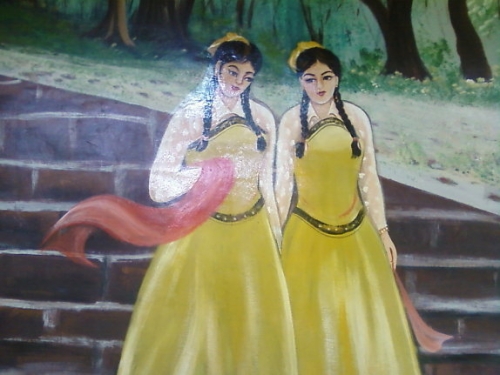Other names: Khach, Han, Tau.
Population: 900,185 people
Local groups: Quang Dong, Quang Tay, Hai Nam, Trieu Chau, Phuc Kien, Sang Phang, Xia PHong, Thang Nham, Minh Huong, He…
Language: The Hoa or Ethnic Chinese, speak a language belonging to the Chinese, language group (Sino-Tibetan language family).
History: The Hoa have migrated to Vietnam in different periods since the 15th century. Later on, other waves of Hoa immigrants came at the end of the Minh, or beginning of the 20th century.
Production activities: In rural areas, the Hoa live mainly as farmers, who plant rice in wet fields. In urban areas, they are active in trading in service businesses. Handicrafts, such as pottery making, is highly developed (in Quang Ninh, Song Be, Dong Nai provinces), as is paper and incense making (in Ho Chi Minh City). Fishing and salt production are economic of a small group of Hoa who live along the coastline. In business, the Hoa always respect the word “trust”
Diet: Rice is the main food. However, they often eat wanton, rice noodle soup, and stir-fried noodles. In middle class family people eat rice soup with salty duck eggs for breakfast. The Hoa have good cooking techniques. They prefer stir-fried dishes with lots of spices. Hoa drinks, on top of quenching one’s thirst, are also considered as medicine: good for the whole body. Ginseng tea, chrysanthemum tea…are popular drinks in every family. On festival occasions, men like to drink wine. Many people smoke tobacco, including women, especially the elderly ones.
Clothing: Hoa traditional dress can only be seen on old people, or on special occasions like weddings and funerals. Women like to wear a blouse with a high collar, buttoned down along one side, and high cuts along each side panel. The long Hoa dress, tight around the hip, and with high cut panel along one side, is also very popular. Women, especially young ones, like to dress in red, pink or dark colors. The men wear black, or dark green shirts, which have buttons on one side, standing collar, and cut panels on the two sides. The shirt with four laps, standing collar, cut in the middle and with pockets, is also popular for men. The women are fond of jewelry, especially bracelets (made of brass, gold, stone, or jade), earrings, and necklaces. The men like to implant gold teeth as an accessory.
.jpg) Housing: Those who are farmers form their own villages that usually lie on the foothills, on terraces, and along beaches. The above sites have the advantage of being close to water sources, and are convenient for traffic and transportation. In the villages, those who have houses close to each other’s are usually relatives. In urban areas, they form their own Hoa neighborhoods.
Housing: Those who are farmers form their own villages that usually lie on the foothills, on terraces, and along beaches. The above sites have the advantage of being close to water sources, and are convenient for traffic and transportation. In the villages, those who have houses close to each other’s are usually relatives. In urban areas, they form their own Hoa neighborhoods.
There are three kinds of houses: those with 3 rooms and 2 wings, those shaped like a gate, and those with shapes like w mouth. They are usually built from stones and bricks, have earthen wall, and have either tile or thatched roofs. Altars to worship ancestors, Buddha, and God stand out in the Hoa house. Carved wooden couplets or parallel sentences, scrolls, and Chinese calligraphy on pink paper pray for luck, success, and peace and are also popular things to hang in the house.
Social organization: The Hoa are highly patriarchal and there are evident differences between the rich and the poor. Relationships among relatives are very important. Each family tree has an ancestor temple for worshipping. Every year, on a specific day, everyone in the family gets together for the anniversary of their ancestors’ death. Business groups and guilds have the same tradition as well. They all have an ancestor founder and a yearly anniversary day. The Hoa have stable, monogamous marriages, and patriarchal family structure. Marriage usually occurs within people of the same local group. The head of a family line, the matchmaker, and local officials play an important role in a marriage. Today, women get married fairly late (average age is 28, 30), and have fewer children (2 to 3 each family).
Festivals: There are many holidays in a year: the Lunar New Year, the festival of the first moon night of the year Pure Light festival, double Five Festival (on the 5th day of 5th lunar month), all Soul’s Day (15th day of 7th lunar month), mid-autumn festival. The Hoa Lunar New Year lasts from those final days of one year to the 15th of January of the next year (lunar calendar). The festival to celebrate the year’s 1st moon is the most important Hoa event, where prominent religious and traditional cultural activities occur.
Beliefs: Ancestors, family spirits, guardian Gods (kitchen God, land God, and the God of wealth), and Buddha are popular worshipped figures. Pagodas and temples are widely developed. They are also the Hoa’s place for a social headquarters or a school, and where communal activities and Festivals take place.
Education: The Chinese language is taught and studied in grade school.
Artistic activities: The Hoa have varieties of traditional culture activities, such as singing, dancing, comedy, etc. they also play a wide range of instruments: several kinds of flutes, moon-shaped flute, zither, two-string Chinese violin, etc. skylark singing (san co) is enjoyed by many younger ones. The popular amateur cultural group that has traditionally been around is called “nhac xa”. Lion, tiger, and dragon dances are popular artistic shows, which are performed everywhere in big Festivals and on New Year’s.






































































































